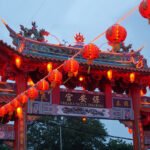🏝️ The Sentinelese: The Island That Defied British Control
North Sentinel Island, located in the Bay of Bengal, is part of the Andaman and Nicobar Islands, which were colonized by the British in the 19th century. But despite British efforts to control and dominate the area, North Sentinel Island and its people resisted colonization.
Here’s why:
- Geographical Isolation
North Sentinel Island is surrounded by shallow reefs and treacherous waters, making it nearly impossible to land on the island by ship. The dense forests and lack of natural harbors further discouraged any extended attempts to colonize. - Hostile Defenses
The Sentinelese people have fiercely defended their land for centuries. They are known to shoot arrows at anyone who approaches their island — including British officers during the colonial period. Their hostile defense has dissuaded even the most determined invaders. - British Strategy Was Limited
The British, focused more on economic exploitation and establishing trade routes, often opted for easier territories to control. The Sentinelese’s resistance and the lack of resources made North Sentinel Island a low priority for the British colonists. - Disease and Infections
The Sentinelese, like other uncontacted tribes, had no immunity to common diseases brought by outsiders, such as smallpox and measles. Early contact could have led to devastating outbreaks for the tribe. The British likely knew that prolonged contact would lead to a humanitarian disaster.
🌍 Other Isolated Tribes and Lands Like North Sentinel Island
Several regions around the world are home to isolated tribes or peoples who have remained largely untouched by modern civilization. Here’s a look at a few:
1. Sentinelese’s Neighbors: The Great Nicobar Islands
The Shompen tribe lives on Great Nicobar Island, part of the Nicobar group in the Andaman and Nicobar Islands. Unlike the Sentinelese, the Shompen are semi-nomadic hunter-gatherers. They are isolated but less hostile than the Sentinelese.
Note: The Indian government has made attempts to provide basic health care to the Shompen but has limited interaction to preserve their way of life.
2. The Jarawa Tribe
Also residing in the Andaman Islands, the Jarawa tribe is another group that has had minimal contact with the outside world. Historically, the Indian government has tried to protect their land from external encroachment. However, some exploitation, such as tourism, has occurred. The Jarawa maintain a semi-nomadic lifestyle and have been known to resist outside contact fiercely.
Recent Developments: There have been attempts to build a road that passes through Jarawa territory, sparking debates about their right to stay undisturbed.
3. The Sentinalese’s Neighbors: The Awa Tribe (Brazil)
Location: The Awa live in the Amazon rainforest in Brazil. Like the Sentinelese, they are one of the last uncontacted tribes. The Awa people fiercely avoid outside contact and have been subjected to deforestation, which threatens their way of life. Brazil’s government, under its “no contact” policy, has tried to protect them.
Warning: The Awa, like other tribes, face the threat of disease from outside contact, which could decimate their population.
4. The Korowai Tribe (Papua New Guinea)
Location: In the Papua New Guinea region, the Korowai tribe is one of the world’s most isolated communities. This tribe lives in treehouses up to 150 feet high, protected from floods, predators, and enemies.
Interesting Fact: The Korowai were undiscovered by the outside world until the 1970s. Their isolation makes them one of the most mysterious tribes in the world.
5. The Uncontacted Tribes of the Amazon (Peru and Brazil)
Location: In the deep jungles of Peru and Brazil, there are several uncontacted tribes that actively avoid contact with the outside world. These tribes live off the land, maintaining a sustainable hunter-gatherer lifestyle.
Efforts to Protect: Both Brazil and Peru have set up protections against outside intrusion, with designated zones where no human contact is allowed.
🛑 Why These Isolated Tribes Remain Untouched
The Sentinelese tribe and other isolated groups remain untouched for several critical reasons:
- Geography: Many of these tribes live in remote and dangerous locations, such as dense forests, mountainous regions, or isolated islands.
- Cultural Resistance: Like the Sentinelese, many tribes have actively rejected contact with outsiders. Their language, beliefs, and lifestyles make them deeply protective of their territory.
- Protection by Law: Governments such as India and Brazil have established no-contact policies to prevent the disruption of these communities and safeguard their health.
- Health Risks: Contact with outside disease vectors could decimate their populations. They lack immunity to common diseases such as flu, measles, or smallpox.
🧐 Conclusion: The Mystery and Respect for Uncontacted Peoples
The Sentinelese tribe, alongside other uncontacted peoples like the Awa and Korowai, remain some of the last groups on Earth who have maintained complete isolation. Their resistance to contact is both a mystery and a reminder of the resilience of cultures that refuse to be erased.
In today’s modern world of constant connection, these isolated peoples remind us that some things are meant to remain undisturbed. The question isn’t just why the British couldn’t invade — it’s also why we need to protect their right to stay hidden, and what we could learn from their way of life.



